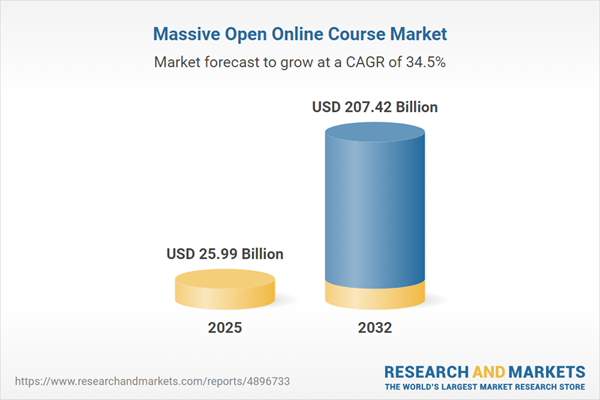Speak directly to the analyst to clarify any post sales queries you may have.
The MOOC market is rapidly transforming enterprise learning by providing organizations with flexible, scalable, and effective pathways for workforce development and compliance management. Senior leaders increasingly view Massive Open Online Courses as decisive tools to address evolving talent needs, operational requirements, and decentralized team structures.
Market Snapshot: MOOC Market Size and Growth Outlook
The global Massive Open Online Course (MOOC) market demonstrates robust expansion, currently valued at USD 19.36 billion with a projected rise to USD 25.99 billion by 2025. Driven by a compound annual growth rate (CAGR) of 34.50%, enterprises in corporate, academic, and regulatory spheres are integrating digital learning solutions to accelerate workforce adaptability and sharpen compliance strategies. Enhanced course diversity and advances in digital delivery further reinforce MOOCs as core enablers for talent development, enabling senior decision-makers to manage multidimensional business environments and regulatory expectations efficiently.
Scope & Segmentation of the Global MOOC Ecosystem
Understanding the range of the global MOOC ecosystem is crucial for aligning digital learning investments with dynamic organizational objectives and regional contexts. This analysis clearly maps out the significant segments impacting strategic workforce and compliance initiatives:
- Course Types: Big Open Online Courses, Connectivist MOOCs, Distributed Open Collaborative Courses, Extended MOOCs, and Small Private Online Courses all serve targeted workforce development and organizational training needs.
- Subject Areas: Arts & Humanities, Business & Management, Health & Medicine, Language Learning, Mathematics & Data Science, Science & Engineering, Social Sciences, and Technology & Computer Science each support sector-relevant and cross-functional upskilling.
- Revenue Models: Enterprise licensing, freemium, pay-per-course, and subscription arrangements provide diverse budgeting and planning options for various learning initiatives.
- Platform Types: Mobile and web-based MOOC platforms offer continuous access for distributed and on-site teams while enhancing global reach.
- Delivery Modes: Instructor-led and self-paced learning support different employee preferences and improve overall training outcomes across workforces.
- Provider Types: Corporate trainers, universities, NGOs, and content specialists deliver sector-specific and certified content tailored to operational and compliance priorities.
- End Users: Enterprises, governments, professionals, NGOs, and academic institutions all utilize MOOCs to drive talent strategies, workforce agility, and compliance management.
- Regions: Americas, Europe, Middle East & Africa, and Asia-Pacific each present unique regulatory, customization, and market adoption factors shaping MOOC success.
- Leading Companies: Coursera, Udemy, 2U, LinkedIn, Pluralsight, Skillshare, FutureLearn, Udacity, Alison Technologies, and OpenClassrooms set operational and technological standards across the MOOC industry.
This segmentation framework enables organizations to design focused learning programs, respond effectively to compliance demands, and deploy workforce strategies suited to local and global conditions.
Key Takeaways for Senior Leaders in the MOOC Market
- Microlearning and adaptive course technologies promote fast, relevant skill acquisition, helping organizations address rapid shifts in market and operational needs.
- Strategic partnerships with universities and technology providers smooth the adoption of advanced digital learning platforms, supporting business transformation initiatives and workforce transitions.
- AI-powered and cloud-based MOOC platforms enhance data security while simplifying onboarding for remote, hybrid, and distributed teams operating across multiple locations.
- Localized and multilingual course content, together with embedded compliance features, address legal requirements and facilitate global workforce engagement.
- Diversified licensing options and flexible pricing models make it possible to allocate learning resources efficiently during shifts in regulatory requirements or organizational priorities.
- Modular curriculum structures and custom course content enable precise compliance tracking and seamless alignment with evolving corporate objectives at the regional level.
Tariff Impact: Navigating Regulatory Headwinds
Recent tariffs on digital services and technologies in the United States are prompting both MOOC providers and enterprise buyers to reassess procurement and deployment strategies. Organizations increasingly invest in local infrastructure, pursue regional partnerships, and prioritize platforms engineered for regulatory compliance. These approaches help sustain consistent learning outcomes as policy landscapes evolve and regulatory challenges intensify.
Methodology & Data Sources
This report synthesizes broad secondary market research with direct insights from enterprise, educational, and public sector stakeholders. It examines the most current MOOC adoption practices, procurement trends, and financial developments to generate clear, actionable recommendations for advancing enterprise learning strategies.
Why This Report Matters
- Supports senior leaders as they refine digital learning approaches to address shifting compliance standards, regional regulations, and emerging technology trends.
- Provides valuable intelligence for organizations seeking to improve workforce upskilling, boost readiness for operational change, and manage complexity effectively.
- Delivers in-depth ecosystem analysis to fortify business continuity, sharpen compliance strategies, and guide effective learning investments in the MOOC market.
Conclusion
By applying the insights from this analysis, senior leaders can tightly align talent management strategies with transformation goals and leverage the MOOC ecosystem to enhance enterprise resilience and long-term workforce strength.
Additional Product Information:
- Purchase of this report includes 1 year online access with quarterly updates.
- This report can be updated on request. Please contact our Customer Experience team using the Ask a Question widget on our website.
Table of Contents
3. Executive Summary
4. Market Overview
7. Cumulative Impact of Artificial Intelligence 2025
Companies Mentioned
The companies profiled in this Massive Open Online Course market report include:- Coursera, Inc.
- Udemy, Inc.
- 2U, Inc.
- LinkedIn Corporation
- Pluralsight, LLC
- Skillshare, Inc.
- FutureLearn Limited
- Udacity, Inc.
- Alison Technologies Limited
- OpenClassrooms SAS
Table Information
| Report Attribute | Details |
|---|---|
| No. of Pages | 189 |
| Published | November 2025 |
| Forecast Period | 2025 - 2032 |
| Estimated Market Value ( USD | $ 25.99 Billion |
| Forecasted Market Value ( USD | $ 207.42 Billion |
| Compound Annual Growth Rate | 34.5% |
| Regions Covered | Global |
| No. of Companies Mentioned | 11 |









